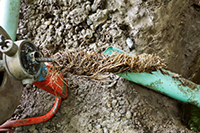16 Aug How Tree Roots Can Disrupt Sewer Lines and Sewer Pipes

Tree Roots and sewer pipes– they just don’t mix. But most people cannot comprehend how tree roots can damage hard metal sewer pipes. The truth is that, soft as they are to begin with, tree roots have incredible strength and can push, weave, and wrap their way around any obstacle, even sewer pipes. And yes, they can break through the pipes laid underground and potentially cause tremendous cost to the owner.
Sewer pipes are something that most people hope they never have to repair as a break in the sewer line means more than just expense- it means stench! But these are some of the primary targets of underground tree roots. Mature trees are the pride of many homeowners. Tall, graceful, and impressive they offer shade and beauty. But with that height comes length, as the roots must grip the underground firmly enough to hold the massively heavy tree up.
Both private and community sewer lines suffer damage from tree roots. Tree roots can break through lines and then begin growing inside them, blocking them partially or wholly. They are responsible for most of the sanitary sewer service backups that occur in communities. But these problems develop slowly and without making homeowners and community members aware until the problem is severe enough to make itself known in a rather unpleasant way.
The reason why this happens so often is simple. Tree roots gravitate towards moisture. Warm water, and yes other warm things, traveling through pipes causes the sewer pipes to release condensation, a warm vapor that is bait for tree roots. Slowly but surely the roots grow towards the source of the warm vapor, until they find a crack, loose joint, or other weakness in the line that they can break through with a tiny sprouted end.
Then these tiny sprouted ends of the roots grow larger and longer as they work their way into the pipe deeper, and open the crack or weak spot to the point of breakage. Household FOGG is a major cause of sewer blockage namely fats, oils, grease, and grit. And when there is a root growing inside a sewer pipe, FOGG can easily collect in a mass that blocks the line.
Whether it is a blockage or a total break, tree root damage usually requires serious work. The area around the tree root and sewer pipe must be dug out, often requiring floors to be opened up to access the area. The affected pipe must be completely replaced and the tree root cut back and preferably redirected. This must all be done without compromising the integrity of the standing tree, or a collapsing tree could create even more costly damage. So, for those homeowners considering planting a tree, it is recommended that trees be planted relatively far away from the side of the house and away from the sewer line to the extent of the property.
Another alternitive to replacing a sewer line that has been damaged by tree roots is using a "No Dig" trenchless sewer repair process known as CIPP Pipelining (Cured-In-Place Point Trenchless Sewer Repair). This is a process where a liner is inserted into a pipe impregnated with a thermosetting resin, which is expanded and cured to form a tight-fitting liner within the sewer pipe, basically, a pipe within a pipe. So if you have one or two areas in sewer line that has been damaged by tree roots, it is only a fraction fo the cost as opposed to digging up your entire sewer line and replasing it.

No Comments